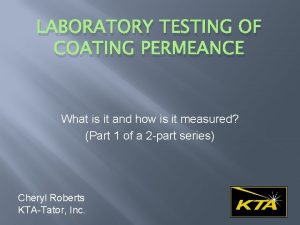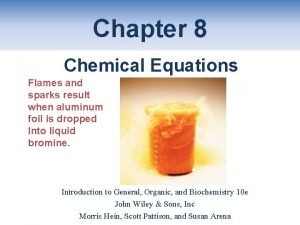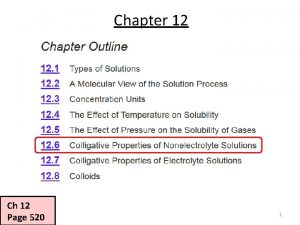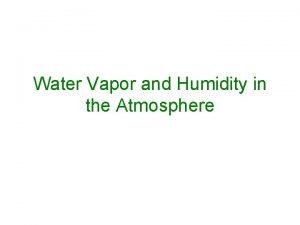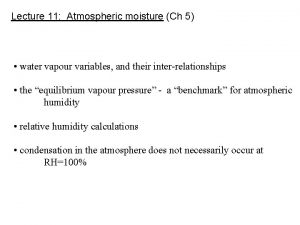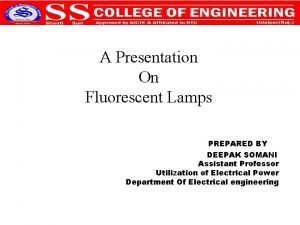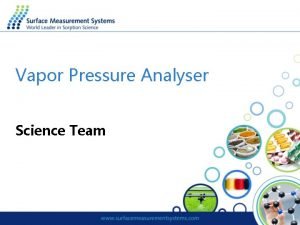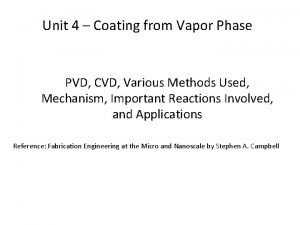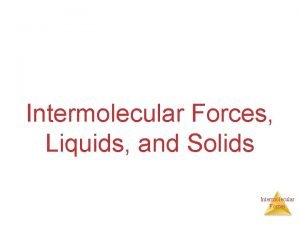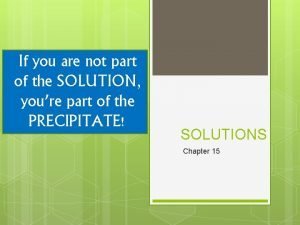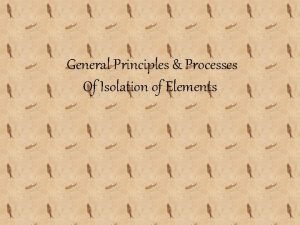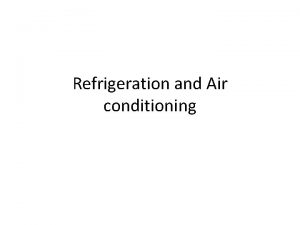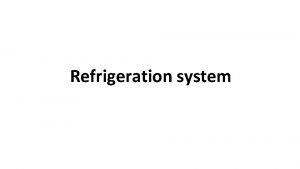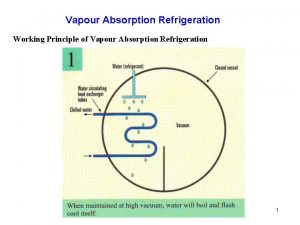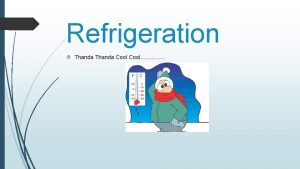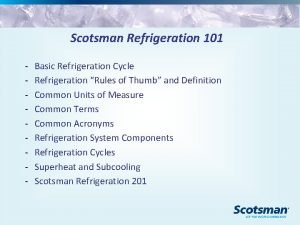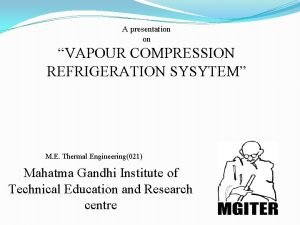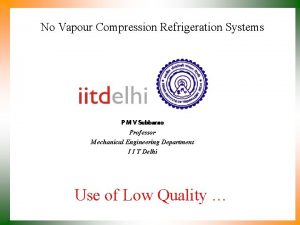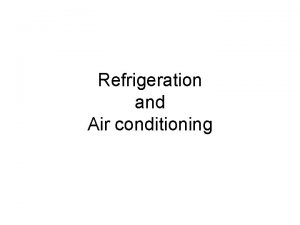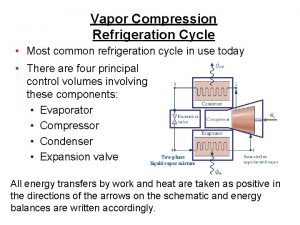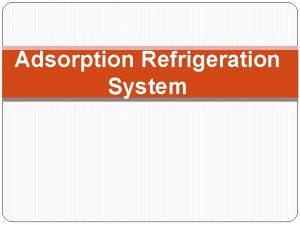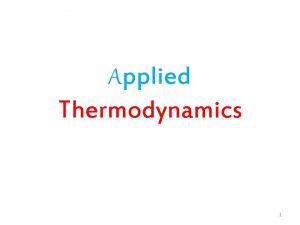G Sathiyaseelan VAPOUR COMPRESSION REFRIGERATION SYSTEM THERMAL ENGINEERING















- Slides: 15

G. Sathiyaseelan VAPOUR COMPRESSION REFRIGERATION SYSTEM THERMAL ENGINEERING MECHANICAL ENGINEERING II YEAR UG STUDENTS IN MECHANICAL ENGINEERING ANNA UNIVERSITY

Out-of-class Activity Design-1 Learning Objective(s) of Out-of-Class Activity At the end of watching the videos student should be able to Understand Ø How the Refrigeration Effect is Produced. Ø What are all the Important components used in the Refrigeration system. Key Concept(s) to be covered Ø Refrigeration Effect. Ø Main components and its functions

Out-of-class Activity Design - 2 Main video source URL https: //www. youtube. com/watch? v=h 5 w. Qo. A 15 On. Q&t=119 s License of Video : CC-BY-SA (Standard You. Tube License) Mapping Concept Video Source CONCEPT VIDEO SEGMENT DURATION (in min) Basic Principle V 1 – 0: 00 – 0: 33 0. 33 How the Refrigeration effect is produced V 2 – 0: 33 – 1: 54 1. 21 Components used V 3 – 1: 54 – 4: 05 2. 51 Performance Calculation V 4 – 4: 05 – 4: 18 0. 13 Total duration : 4. 18 minutes

Out-of-class Activity Design - 3 Aligning Assessment with Learning Objective How the Refrigeration Effect is Produced Assessment Strategy Expected Duration (in min) Q 1. What is the use of home refrigerator? Q 2. How the apple Should be cooled Inside the refrigerator? 5 minutes Additional Instructions (if any) Watch V 1 and then answer Q 1 Watch V 2 and then answer Q 2

Out-of-class Activity Design - 3 Aligning Assessment with Learning Objective Assessment Strategy Components used in Q. 1. How the Cooling the Refrigeration Effect is achieved inside System the system and what are all the components used to do this? Expected Duration (in min) Additional Instructions (if any) 10 minutes Watch V 3 & V 4 then answer Q 1

In-class Activity Design -1 Learning Objective(s) of In-Class Activity At the end of the class, students will be able to, § Solve real-life scenario problems involving selection of the Refrigeration systems that is suitable for the Application. Key Concept(s) to be covered § Types of Refrigeration System. § Components Used. § Co effiecient of performance

In-class Activity Design -2 Active Learning activity(ies) that you plan to do Real world problem solving using. § Think-Pair-Share Concept clarification using. § Peer Instruction 7

In-class Activity Design -2 Peer Instruction Strategy – What Teacher Does Pose the two PI questions at the start of the class and provide summary of the working principle and the construction of the instrument. Q 1: The bank of tubes at the back of domestic refrigerator is (A) Condenser tubes (B) Evaporator tubes (C) Refrigerant cooling tubes (D) Capillary tubes 8

In-class Activity Design -2 Peer Instruction Strategy – What Teacher Does Q 2: The condition of refrigerant after passing through the condenser in a vapour compression system is (A) Saturated liquid (B) Wet vapour (C) Dry saturated vapour (D) Superheated vapour 9

In-class Activity Design -2 Peer Instruction Strategy – What Student Does § § § For each question they will first vote individually. Then they will discuss with peers and come to consensus. Listen to instructors explanation. 10

In-class Activity Design -2 TPS Strategy – What Instructor does An ideal vapor-compression refrigerant cycle operates at steady state with Refrigerant 134 a as the working fluid. Saturated vapor enters the compressor at -100 C, and saturated liquid leaves the condenser at 280 C. The mass flow rate of refrigerant is 5 kg/min. Determine (i) The coefficient of performance. 11

In-class Activity Design -2 TPS Strategy – What Instructor does Think (~3 minutes) Instruction: Read The given Problem Then Draw the Refrigeration Cycle and T-S Diagram for the vapour compression cycle Think individually and identify way how to calculate the COP and write its Mathematical Formulations. 12

In-class Activity Design -2 TPS Strategy – What Instructor does Pair (~5 minutes) Instruction: Now pair up and compare your answers. Agree on one final answer. While students are pairing and discussing, instructor goes to 2~3 sections to see what they are doing. 13

In-class Activity Design -2 TPS Strategy – What Instructor does Share (~6 minutes) Instructor asks a group to share their answer with class and see whethere are different answers. After sharing is done, instructor gives feedback on the correct solution 14

In-class Activity Design -2 Justify why the above is an active learning strategy In the above strategies, students are required to go beyond mere listening and execution of prescribed steps. They are required to think deeply about the content they were familiarized in out-of-class and do higher order thinking. There is also feedback provided (either through peer discussion or instructor summary) 15
 Section 3 using heat worksheet answers
Section 3 using heat worksheet answers Thermal transfer vs direct thermal printing
Thermal transfer vs direct thermal printing Vapour pressure
Vapour pressure Vapor density formula
Vapor density formula Water vapour transmission astm1653
Water vapour transmission astm1653 Practice writing chemical equations
Practice writing chemical equations Phosphorus equation
Phosphorus equation Lowering of vapour pressure formula
Lowering of vapour pressure formula Water vapour formula
Water vapour formula How to find vapor pressure of water
How to find vapor pressure of water Mercury vapour lamp
Mercury vapour lamp Vapour pressure analyser
Vapour pressure analyser Pvd vs cvd
Pvd vs cvd Vapour pressure
Vapour pressure Relative lowering of vapour pressure formula
Relative lowering of vapour pressure formula Short note on vapour phase refining
Short note on vapour phase refining




